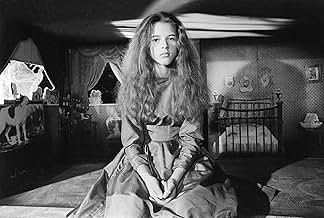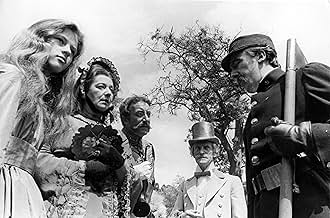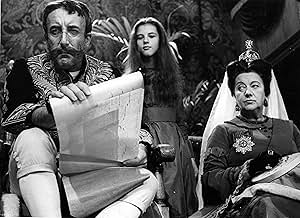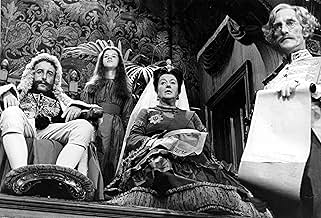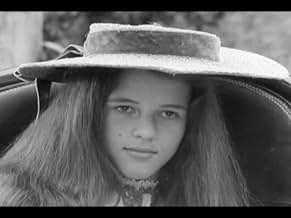IMDb रेटिंग
6.7/10
1.1 हज़ार
आपकी रेटिंग
अपनी भाषा में प्लॉट जोड़ेंA girl named Alice falls down a rabbit-hole and wanders into the strange Wonderland.A girl named Alice falls down a rabbit-hole and wanders into the strange Wonderland.A girl named Alice falls down a rabbit-hole and wanders into the strange Wonderland.
- निर्देशक
- लेखक
- स्टार
Jo Maxwell Muller
- Alice's Sister
- (as Jo Maxwell-Muller)
Michael Redgrave
- Caterpillar
- (as Sir Michael Redgrave)
Anthony Trent
- Fish Footman
- (as Tony Trent)
- …
Wilfrid Lawson
- Dormouse
- (as Wilfred Lawson)
फ़ीचर्ड समीक्षाएं
Working with a shoestring budget director Jonathan Miller was able to persuade an impressive cast (Peter Sellers, Sir Michael Redgrave, Sir John Gielgud, Peter Cook, Alan Bennett, Michael Gough, Wilfred Brambell, Wilfred Lawson, Leo McKern, Malcolm Muggeridge, Finlay Currie) to make cameo appearances in his BBC production of "Alice in Wonderland". The results are mixed, with some bright spots (especially the few improvisations Miller left in).
Miller dresses his cast like Victorians, rather than making them look like animals (after all, he says in his commentary, the typical way of doing Alice is to take big stars and then cover them up with animal heads so you can't see who they are).
He takes the book literally. For instance, the Hatter and the March Hare are mad in a real way rather than the typically overblown cartoonish way. Peter Cook's Hatter is soft-spoken, laughing and agreeable, his lines always sounding like non sequiturs; while Michael Gough's March Hare is defensive, suspicious, and genuinely troubling.
The best scene, which probably best captures what Miller was working for, was Muggeridge's Gryphon and Gielgud's Mock Turtle. The fey White Rabbit of Wilfred Brambell ("A Hard Day's Night") is a delight. Peter Sellers, appearing all too briefly, has an amusing bit of business (Miller in his commentary doesn't like it but it suits the scene admirably and in this case Sellers the slapstick authority knew what he was doing better than the director -- the scene cries out for what he does). Michael Redgrave is phenomenal in his all-too-brief turn as the caterpillar, but the scene is damaged by truncating the poem "You are Old, Father William" to the point that it makes no sense on any level. Peter Cook's Hatter is engaging at first but his one-note madness is quickly tiresome. More interesting at the tea party is Wilfred Lawson's Door Mouse (watch his hands -- he knows his business); and Michael Gough ("Batman"), who has an aura of danger.
The pros in the cast all do their best, and no fault can be found with the big-name stars who are doing good work for peanuts.
Miller's concept of Alice is the primary reason the film ultimately doesn't work. The girl he chose as Alice has a very interesting face, and is wonderfully untraditional. Sometimes her delivery (heard half in voice-over and half in dialog) shows promise. But Miller, probably to accentuate the dreamlike fixation, has her walk through the movie like a somnambulist, not becoming involved. The little emoting he does allow is almost always to show Alice's rudeness. For the most part her facial expression is fixed and unengaged, and this is Miller's fault.
The cutting from scene to scene is abrupt. Part of this is probably Miller's continued obsession with the working of dreams, and partly because a lot of transitional material was cut out at the request of the bigwigs to make the show move faster. And because Miller is quite literal with Carroll, he makes the mad tea party actually have the monotonous languor of people trapped in a long afternoon tea that will never stop -- and it becomes tedious.
Oddly, on the DVD, far better than the movie is the director's audio track. Jonathan Miller gives a full 80 minute's description of what he tried to do (and what price limitations left him able to do); and when the movie is seen in that light, it makes a lot more sense. Sometimes Miller explains why things were done, sometimes he desperately tries to justify what was done. In all cases, his commentary is interesting and he never falls into the trap of describing what's going on, but always why it's going on.
The movie looks good, and individual turns by actors are superb, but the whole is less than the sum of its parts.
Miller dresses his cast like Victorians, rather than making them look like animals (after all, he says in his commentary, the typical way of doing Alice is to take big stars and then cover them up with animal heads so you can't see who they are).
He takes the book literally. For instance, the Hatter and the March Hare are mad in a real way rather than the typically overblown cartoonish way. Peter Cook's Hatter is soft-spoken, laughing and agreeable, his lines always sounding like non sequiturs; while Michael Gough's March Hare is defensive, suspicious, and genuinely troubling.
The best scene, which probably best captures what Miller was working for, was Muggeridge's Gryphon and Gielgud's Mock Turtle. The fey White Rabbit of Wilfred Brambell ("A Hard Day's Night") is a delight. Peter Sellers, appearing all too briefly, has an amusing bit of business (Miller in his commentary doesn't like it but it suits the scene admirably and in this case Sellers the slapstick authority knew what he was doing better than the director -- the scene cries out for what he does). Michael Redgrave is phenomenal in his all-too-brief turn as the caterpillar, but the scene is damaged by truncating the poem "You are Old, Father William" to the point that it makes no sense on any level. Peter Cook's Hatter is engaging at first but his one-note madness is quickly tiresome. More interesting at the tea party is Wilfred Lawson's Door Mouse (watch his hands -- he knows his business); and Michael Gough ("Batman"), who has an aura of danger.
The pros in the cast all do their best, and no fault can be found with the big-name stars who are doing good work for peanuts.
Miller's concept of Alice is the primary reason the film ultimately doesn't work. The girl he chose as Alice has a very interesting face, and is wonderfully untraditional. Sometimes her delivery (heard half in voice-over and half in dialog) shows promise. But Miller, probably to accentuate the dreamlike fixation, has her walk through the movie like a somnambulist, not becoming involved. The little emoting he does allow is almost always to show Alice's rudeness. For the most part her facial expression is fixed and unengaged, and this is Miller's fault.
The cutting from scene to scene is abrupt. Part of this is probably Miller's continued obsession with the working of dreams, and partly because a lot of transitional material was cut out at the request of the bigwigs to make the show move faster. And because Miller is quite literal with Carroll, he makes the mad tea party actually have the monotonous languor of people trapped in a long afternoon tea that will never stop -- and it becomes tedious.
Oddly, on the DVD, far better than the movie is the director's audio track. Jonathan Miller gives a full 80 minute's description of what he tried to do (and what price limitations left him able to do); and when the movie is seen in that light, it makes a lot more sense. Sometimes Miller explains why things were done, sometimes he desperately tries to justify what was done. In all cases, his commentary is interesting and he never falls into the trap of describing what's going on, but always why it's going on.
The movie looks good, and individual turns by actors are superb, but the whole is less than the sum of its parts.
I'm not sure I completely buy Jonathan Miller's account of the book, but his interpretation (as he explains it on the commentary track) is pretty wonderful on balance. It's funny, surprising, beautiful and mostly about the nature of dreams. The cast, for fans of British movies and TV of the period, may have never been equaled. There's one from "Help", there's one from "A Hard Day's Night", there's the midget from "The Prisoner!" Wonderful. The only real question is "Where's Dudley Moore?" At any rate, I just found out about this movie, it's only been out on DVD for a year or two but it's one I think I will always treasure.
A fascinatingly, surreal and psychedelic version of the Alice in Wonderland story. Shot in a Gothic black and white style, the cinematography is very well done and still holds up 50 years later.
The cast is very very good, particularly Anne-Marie Malik in her one and only role of Alice. She's petulant and outspoken, but also very reserved and examining. She's adorable, and her delivery of lines add to the dreamlike quality of the movie. She makes the whole movie worth watching.
Filmed as a TV play it's surprisingly well made, thank the BBC for that, they do some exceptional work.
Jonathan Miller's Alice in Wonderland is worth viewing if you can find it.
The cast is very very good, particularly Anne-Marie Malik in her one and only role of Alice. She's petulant and outspoken, but also very reserved and examining. She's adorable, and her delivery of lines add to the dreamlike quality of the movie. She makes the whole movie worth watching.
Filmed as a TV play it's surprisingly well made, thank the BBC for that, they do some exceptional work.
Jonathan Miller's Alice in Wonderland is worth viewing if you can find it.
Alice in Wonderland is one of the most astounding works of literature. It has therefore inspired many entertainers to do many different variations of Wonderland and its sequel, Through the Looking Glass.
Jonathan Miller's BBC version is extremely different from most adaptations of Alice, especially the Disney version (which is not really the most accurate portrayal of Lewis Carroll's logically illogical world). Miller evokes a rather haunting and surrealistic Victorian dreamworld filled with stuffy grown-ups numbly adhering to propriety and social etiquette. Alice is lost in this landscape, trying to find herself and trying to understand the process of growing up.
This variation is clearly more suitable for adults, since the mood is darker and none of the characters have any makeup at all. But the cast is excellent, with appearances by such legends as Sir Michael Redgrave, Sir John Gielgud, and Peter Sellers. Anne-Marie Mallik portrays a more sullen Alice but is perfect for this version of Wonderland.
A unique and artistic production- a must for Alice fans who like to see Lewis Carroll in all forms!
Jonathan Miller's BBC version is extremely different from most adaptations of Alice, especially the Disney version (which is not really the most accurate portrayal of Lewis Carroll's logically illogical world). Miller evokes a rather haunting and surrealistic Victorian dreamworld filled with stuffy grown-ups numbly adhering to propriety and social etiquette. Alice is lost in this landscape, trying to find herself and trying to understand the process of growing up.
This variation is clearly more suitable for adults, since the mood is darker and none of the characters have any makeup at all. But the cast is excellent, with appearances by such legends as Sir Michael Redgrave, Sir John Gielgud, and Peter Sellers. Anne-Marie Mallik portrays a more sullen Alice but is perfect for this version of Wonderland.
A unique and artistic production- a must for Alice fans who like to see Lewis Carroll in all forms!
Probably will remain in my top 3 Alice in Wonderland film adaptations (it only covers the first book), just below Svankmajer's wonderfully surreal stop-motion version, titled Alice, and I'm somewhat ambivalent about whether I prefer the Disney version or not-it's nicely colored and the characters are more similar to the drawings In Carroll's book, but it has the goofiness of a Disney film, of course. This adaptation is quite faithful to the original book, though a few scenarios might have been removed for time or were altered in some way, but most of the dialogue remains the same.
I was expecting it to feel more like a big studio production, and while the production values were quite good, it's not reminiscent of a Hollywood film or the British equivalent. It has the aura of a B&W art film-and the girl playing Alice (makes me think of a French New Wave heroine), who never smiles, often scowls, is rather sullen, often avoids eye contact or talks while not even looking at the character she's speaking to, and is clearly older than 7 (I believe that was the stated age of Alice in the book). Though she's a bit sassy in the book and not a push over or anything, her behavior seems altered quite a bit based off my, admittedly somewhat time-eroded, memories of Alice and Wonderland. The other change is, while the film is quite faithful in terms of the scenes adapted, the actors are all humans with no attempts to dress them up as the curious assortment of talking animals, odd creatures, and flat card-like men and women found in the book.
The choice of sitar music, with occasional accompaniment, by Ravi Shankar (and someone else I hadn't heard of on oboe) was an interesting and surprisingly fitting choice. I always imagined Canterbury prog or some old folk music with flutes.
In some sense I think it has a more dream-like continuity than the book, because the whimsical passages of Carroll lend's the novel a more structured and deliberate quality, compared to the way the scenes flow and our edited in this version.
I was expecting it to feel more like a big studio production, and while the production values were quite good, it's not reminiscent of a Hollywood film or the British equivalent. It has the aura of a B&W art film-and the girl playing Alice (makes me think of a French New Wave heroine), who never smiles, often scowls, is rather sullen, often avoids eye contact or talks while not even looking at the character she's speaking to, and is clearly older than 7 (I believe that was the stated age of Alice in the book). Though she's a bit sassy in the book and not a push over or anything, her behavior seems altered quite a bit based off my, admittedly somewhat time-eroded, memories of Alice and Wonderland. The other change is, while the film is quite faithful in terms of the scenes adapted, the actors are all humans with no attempts to dress them up as the curious assortment of talking animals, odd creatures, and flat card-like men and women found in the book.
The choice of sitar music, with occasional accompaniment, by Ravi Shankar (and someone else I hadn't heard of on oboe) was an interesting and surprisingly fitting choice. I always imagined Canterbury prog or some old folk music with flutes.
In some sense I think it has a more dream-like continuity than the book, because the whimsical passages of Carroll lend's the novel a more structured and deliberate quality, compared to the way the scenes flow and our edited in this version.
क्या आपको पता है
- ट्रिवियाMost of this movie was shot with a 9mm camera lens.
- गूफ़In the scenes with the Mock Turtle, his legs are crossed in all the long shots, but in close-up shots, his legs are in a completely different position; without there being enough time to have changed them from one shot and another.
- क्रेज़ी क्रेडिटThe end credits use Lewis Carroll's original ink drawings from his handwritten manuscript (called 'Alice's Adventures Under Ground') now in the British Library.
- कनेक्शनFeatured in The Worlds of Fantasy: The Child Within (2008)
टॉप पसंद
रेटिंग देने के लिए साइन-इन करें और वैयक्तिकृत सुझावों के लिए वॉचलिस्ट करें
विवरण
- रिलीज़ की तारीख़
- कंट्री ऑफ़ ओरिजिन
- आधिकारिक साइट
- भाषा
- इस रूप में भी जाना जाता है
- Alice Harikalar Diyarında
- फ़िल्माने की जगहें
- उत्पादन कंपनी
- IMDbPro पर और कंपनी क्रेडिट देखें
- चलने की अवधि1 घंटा 12 मिनट
- रंग
- ध्वनि मिश्रण
- पक्ष अनुपात
- 1.33 : 1
इस पेज में योगदान दें
किसी बदलाव का सुझाव दें या अनुपलब्ध कॉन्टेंट जोड़ें




